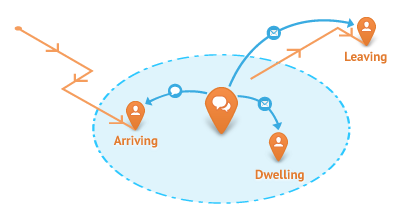Introduction
Say you want to build an app that will push a message to a user when they're near a certain location at a certain time of day. Perhaps you think, based on data you've gathered about this person, that they'd be interested in a particular museum tour. If the tour starts at 2:00 and the person is within a half-mile of it at that time, your app could let them know. With the Geotrigger SDK, you can accomplish this quickly and easily. Our geofencing libraries are more accurate than native ones and we've fine-tuned our algorithms to make them fast and use minimal computing power, thus making your user's phone batteries last longer.
Events can be triggered in a variety of ways, too. For example, you could trigger an event when a user arrives at a place, after they've been in a location for a certain length of time, or when they leave a geofenced area.
Geoloqi can notify your server so you can script custom events that engage users. You can use the API to programmatically create a collection of places and set up triggers on those places. You can use this to integrate Geoloqi with your existing data sets, or automate the creation of places.
Trigger geofences based on events like
- entering, dwelling, or leaving a place
- time of day
- crossing a speed threshold
- entering a city, state or country (coming soon)
- after traveling a given distance (coming soon)
- after a particular change in altitude (coming soon)
Sample Code
# Create a new place with a radius of 1500 meters
place = geoloqi.post "place/create", {
:latitude => 45.5246,
:longitude => -122.6843,
:radius => 1500,
:text => "Downtown Portland"
}
# Trigger the API to send a callback to your server
# when a device/user enters this place.
trigger = geoloqi.post "trigger/create", {
:place_id => place.place_id,
:type => "callback",
:url => "http://example.com/your_app"
}
